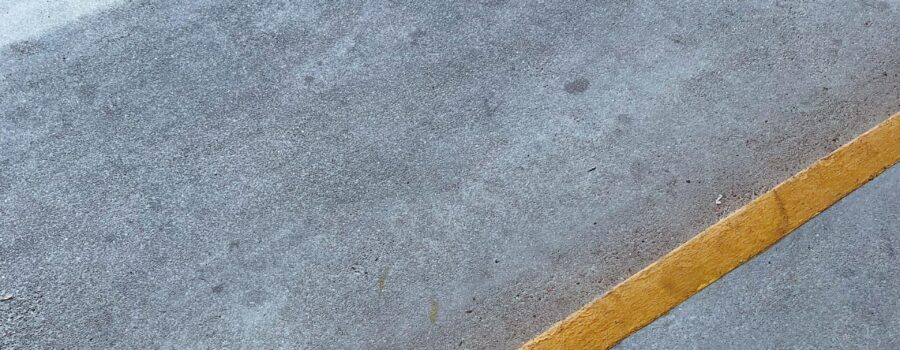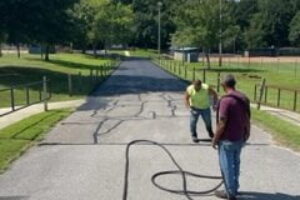Why Sealcoat Your Driveway?
Sealcoating your asphalt driveway offers numerous benefits, making it a vital maintenance practice for homeowners. One of the primary reasons to sealcoat is the protection it provides against weather damage. Asphalt driveways are exposed to various elements such as rain, snow, and ice, which can cause cracks and potholes over time. By applying a sealcoat, you create a barrier that prevents water from penetrating the surface, reducing the risk of damage and extending the life of your driveway.
UV rays from the sun are another factor that contributes to the deterioration of asphalt. Prolonged exposure to UV radiation can lead to the oxidation of the asphalt binder, causing it to become brittle and more susceptible to cracking. Sealcoating acts as a protective shield against harmful UV rays, preserving the flexibility and integrity of the asphalt. This can significantly prolong the lifespan of your driveway.
Additionally, chemical spills such as oil, gasoline, and other automotive fluids can deteriorate asphalt. These substances can weaken the structure of the driveway, leading to potential crumbling and the need for extensive repairs. Asphalt Sealcoating creates a resistant surface that prevents these chemicals from seeping into the asphalt, thereby safeguarding its longevity.
From an aesthetic perspective, sealcoating enhances the appearance of your driveway by providing a uniform, dark finish. Over time, asphalt can become discolored due to various external factors. A fresh sealcoat gives the driveway a revitalized, clean look, which can improve the overall curb appeal of your property.
Financially, sealcoating is a cost-effective solution for maintaining your asphalt driveway. Regular maintenance through sealcoating can prevent minor issues from escalating into major, costly repairs. According to industry experts, the investment in routine sealcoating can save homeowners up to 48% in repair costs over the lifespan of the driveway.
In conclusion, sealcoating is a beneficial practice for protecting, preserving, and enhancing your asphalt driveway. The combined advantages of weather resistance, UV protection, chemical spill defense, and improved aesthetics underscore its importance as a preventive measure.
The Price of Sealcoating: What to Expect
Understanding the costs associated with asphalt sealcoating is crucial for homeowners looking to maintain their driveways. On average, you can expect to pay between $0.10 and $0.40 per square foot for basic sealcoating services. However, various factors can significantly influence this cost including geographic area, how much cleaning the asphalt needs, etc.
One of the primary determinants of the price is the size of the area to be treated. Larger driveways tend to benefit from lower per-square-foot costs due to economies of scale. Conversely, smaller driveways might incur higher rates due to the fixed costs of mobilizing equipment and labor.
The condition of the asphalt also plays a crucial role in pricing. Driveways that are in good condition require less preparation work, making the process more straightforward and less costly. In contrast, driveways with cracks, potholes, or significant wear may need extensive prep work, such as crack filling and pothole repair, which can substantially increase the overall cost.
Different sealcoating materials come with varying price tags. For instance, coal tar-based sealers, known for their durability, generally cost more than asphalt emulsion sealers. The choice of material can influence both the short-term expense and long-term maintenance costs, as higher-quality materials may extend the intervals between resealing.
Additionally, homeowners should be cautious of hidden fees that may not be included in the initial estimate. These can include charges for prep work, additional labor, or travel fees for contractors servicing areas further from their base location.
To get the best value, homeowners should consider obtaining multiple quotes and be mindful of regional pricing differences. Prices can vary widely based on local labor costs, material availability, and climate conditions. Keeping an eye out for special promotions or discounts, especially during the off-season, can also result in significant savings.
In summary, while the base cost of asphalt sealcoating is relatively straightforward, several factors, such as driveway size, asphalt condition, and material choice, can influence the final price. Awareness of hidden fees, regional pricing, and promotional offers can help homeowners make more informed decisions and secure the best possible value for their investment.
Dealing with Cracks and Oil Stains Before Sealcoating
Properly addressing cracks and oil stains before sealcoating is vital for achieving a long-lasting, effective sealcoat application. Cracks in the asphalt are more than just unsightly; they can widen and deteriorate further when left untreated, allowing water to penetrate and potentially cause severe damage to the pavement’s foundation. Therefore, repairing these imperfections should be the first step in preparing your asphalt surface for sealcoating.
There are two primary methods to repair cracks: crack filling and patching. Crack filling is generally used for minor to moderate cracks. This process involves cleaning out the cracks of debris and vegetation and then filling them with a hot or cold pour rubberized sealant. This method prevents water infiltration and provides a temporary bond. On the other hand, patching is more appropriate for larger cracks or potholes. Patching involves removing the damaged area, treating the underlying sub-base if necessary, and filling it with new asphalt. Whichever method is chosen, the key is to ensure the repaired areas are even with the existing pavement to prevent any tripping hazards or further deterioration.
Oil stains present another challenge that must be resolved before sealcoating. Oil spills can weaken the asphalt binder and interfere with the adhesion of the sealcoat. Removal techniques generally include power washing with degreasers or specialized asphalt cleaners to break down the oil and remove it fully. In some instances, applying an oil spot primer may be necessary to neutralize the oil stain and promote better adhesion of the sealcoat.
While minor repairs and cleaning can be handled by homeowners with the right tools and materials, more extensive damage and stubborn oil stains often require professional intervention. Professionals bring expertise, specialized equipment, and high-quality materials that ensure durable and efficient repair work, laying a strong foundation for the asphalt sealcoating process.
Sealcoat Application Process and Post-Sealcoating FAQs
The application of sealcoat to an asphalt driveway follows a precise, methodical process designed to ensure optimal results. Initial surface preparation is essential. This involves cleaning the driveway thoroughly to remove any debris, grease, or oil spots. Utilizing a pressure washer or a stiff-bristled broom can help achieve a clean, debris-free surface. If there are any surface cracks or holes, these need to be repaired before applying the sealcoat.
Next, the sealcoat application begins. Professionals typically use either a squeegee or a specialized sprayer to evenly distribute the sealcoat material across the surface. This process may require multiple coats, depending on the asphalt’s current condition and the desired level of protection. Between each layer, allow sufficient drying time, which varies based on the specific sealcoat product used and prevailing weather conditions.
Once the sealcoating is complete, several commonly asked questions emerge regarding post-sealcoating care. To start, homeowners often wonder when they can park on their driveway. Generally, at least 24-48 hours of drying time is recommended before vehicles can use the driveway. During this curing period, it is crucial to keep the area free from foot traffic and any objects that could mar the surface.
Approving the completed work involves inspecting the driveway for uniform coverage and consistent color. Look for any missed spots or areas that require touch-ups. Discuss any concerns with your service provider to ensure satisfaction before making payment. Payment methods usually include credit cards, checks, and occasionally cash, depending on the contractor’s policies.
Scheduling sealcoating services necessitates consideration of weather conditions, as rain or extreme temperatures can compromise the quality of the sealcoat. Ideally, choose a period with mild, dry weather forecasts. The entire process typically takes a few hours to a day, depending on factors such as the size of the driveway and the drying conditions.
Maintaining your newly sealed driveway is vital for prolonging the benefits of the sealcoat. Regularly remove debris, promptly clean up any oil spills, and consider periodic touch-up applications to maintain the driveway’s integrity. Following these steps will ensure that your asphalt driveway remains in excellent condition for years to come.




Leave a Reply
Your email is safe with us.